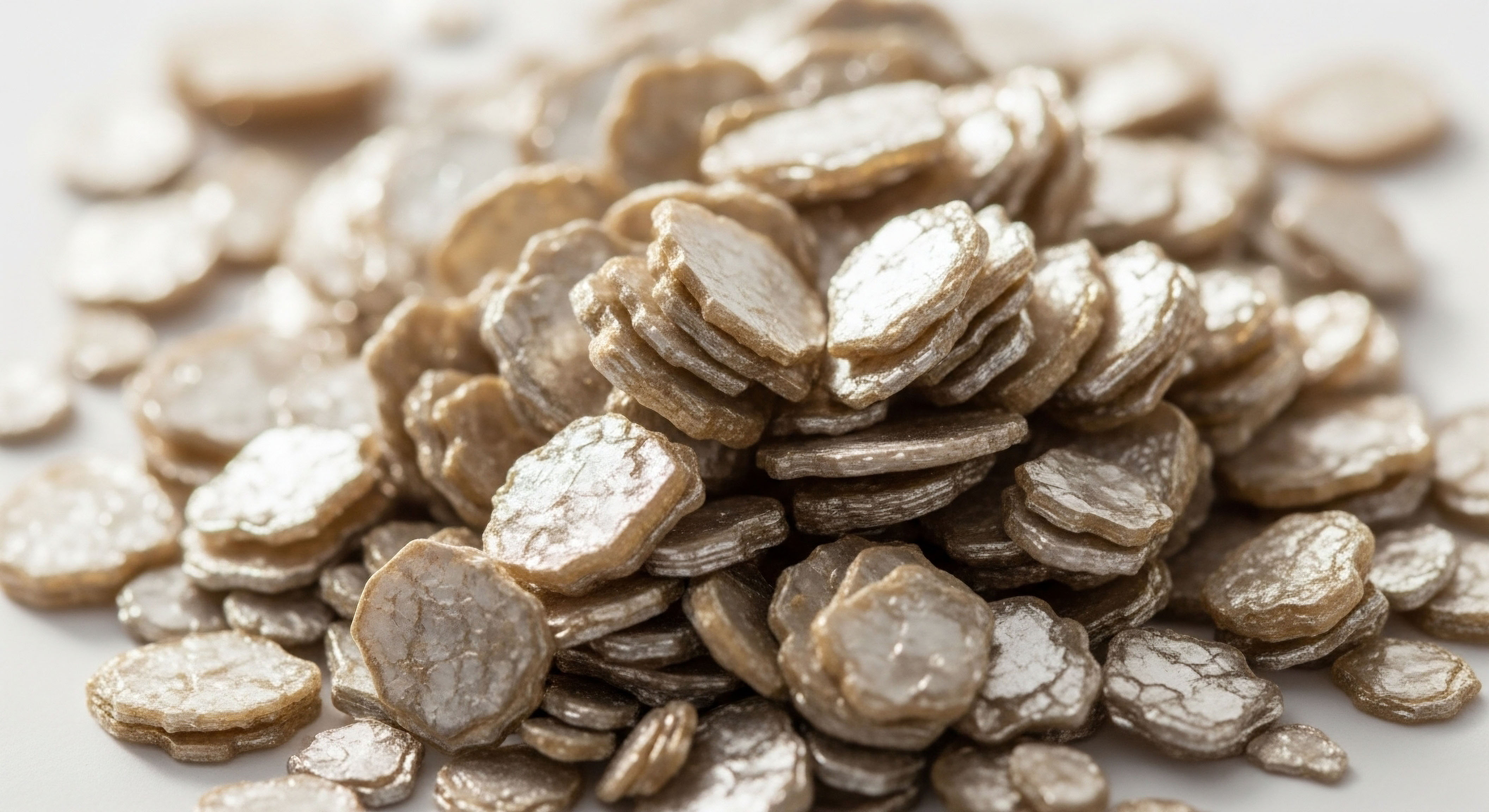

Fundamentals
The feeling often begins subtly. It might be a persistent lack of energy that coffee no longer fixes, a noticeable decline in physical strength, or a mental fog that clouds focus. These experiences are not abstract complaints; they are direct signals from a complex internal communication network that is running into difficulty.
Your body is communicating a disruption, and understanding the language of that system is the first step toward addressing it. At the center of this particular conversation is the intricate machinery of testicular function, a system profoundly sensitive to the daily inputs of your life.
We can visualize the testes as highly specialized manufacturing plants. Their primary product is testosterone, a molecule with a system-wide job description that includes maintaining muscle mass, bone density, cognitive drive, and metabolic regulation. Like any advanced factory, this one does not operate in isolation.
It receives its production orders from a central command center in the brain, a coordinated partnership between the hypothalamus and the pituitary gland. This entire operational chain is known as the Hypothalamic-Pituitary-Gonadal (HPG) axis. The hypothalamus sends a signal, Gonadotropin-Releasing Hormone (GnRH), to the pituitary. The pituitary, in response, releases Luteinizing Hormone (LH) and Follicle-Stimulating Hormone (FSH) into the bloodstream. These hormones travel to the testes and give the order to produce testosterone and initiate spermatogenesis.
A healthy hormonal axis functions like a finely tuned thermostat, constantly adjusting output based on the body’s needs.
This entire system is governed by a sophisticated feedback loop. When testosterone levels are sufficient, they send a signal back to the hypothalamus and pituitary to slow down the production of GnRH and LH. This prevents overproduction and maintains a state of equilibrium, or homeostasis.
The lived experience of vitality and wellness is, in large part, the subjective feeling of this system operating smoothly and efficiently. The fatigue, low mood, and physical decline are the tangible results of this system being compromised.

The Foundational Pillars of Systemic Health
Before considering any external intervention, it is essential to evaluate the foundational conditions under which this hormonal factory operates. Lifestyle modifications are the process of optimizing the factory’s environment, power supply, and raw materials. Without this optimization, even the most advanced clinical protocols may struggle to achieve their intended effect or may require higher doses to overcome systemic resistance. These foundational pillars are not suggestions; they are biological prerequisites for healthy endocrine function.

Sleep the System’s Nightly Reset
The majority of daily testosterone production is synchronized with sleep, specifically deep, restorative sleep. The pulsatile release of LH, the key signal for testosterone synthesis, is most active during these hours. Chronic sleep deprivation, even just a few nights of restricted sleep, directly interrupts this process.
The command center (the hypothalamus and pituitary) is unable to send its signals effectively, leading to a direct drop in testosterone output the following day. Insufficient sleep also increases levels of cortisol, a stress hormone that actively suppresses the HPG axis, further compounding the issue. Restoring a consistent sleep schedule of 7-9 hours is a non-negotiable first step in any restoration protocol.

Nutrition the Fuel and Building Blocks
The food you consume provides both the energy and the specific molecular components required for hormone production. Testosterone is synthesized from cholesterol; therefore, a diet severely deficient in healthy fats can limit the availability of this essential precursor. Furthermore, the body’s overall metabolic state, governed by nutrition, has a profound impact on testicular function.
A diet high in processed carbohydrates and sugars can lead to insulin resistance, a condition where the body’s cells no longer respond effectively to the hormone insulin. Chronic high insulin levels are directly toxic to the HPG axis, suppressing LH release and lowering testosterone production. Conversely, a diet rich in whole foods, quality proteins, healthy fats, and micronutrients like zinc and vitamin D provides the necessary components for optimal steroidogenesis.

Movement the Metabolic Regulator
Physical activity, particularly resistance training and high-intensity interval training, has been shown to support healthy testosterone levels. Exercise improves insulin sensitivity, which helps to correct the metabolic dysfunction that suppresses the HPG axis. It also helps manage body composition, particularly reducing visceral fat.
This type of deep abdominal fat is not inert; it is a metabolically active organ that produces an enzyme called aromatase. Aromatase converts testosterone into estrogen, directly reducing circulating testosterone levels and disrupting the sensitive hormonal balance required for proper HPG axis feedback. Regular movement is a powerful tool for both stimulating androgen production and protecting the testosterone already present.

Stress Management the Signal Scrambler
The body’s stress response system, governed by the hormone cortisol, operates in direct opposition to the reproductive axis. From a biological perspective, a state of chronic stress signals that it is not a safe time for functions like reproduction or long-term rebuilding.
High cortisol levels send a powerful inhibitory signal to the hypothalamus, reducing GnRH output and consequently shutting down the entire HPG axis. Techniques that mitigate chronic stress, such as mindfulness, meditation, or even dedicated time in nature, can lower cortisol and remove this suppressive brake from the system, allowing for a return to normal function.
Addressing these four pillars constitutes the essential groundwork for any testicular function restoration protocol. They are the lifestyle modifications that recalibrate the body’s internal environment, creating a state that is receptive to further, more targeted clinical support if needed.


Intermediate
Understanding that lifestyle factors influence testicular function is the first step. The next is to appreciate the precise biological mechanisms through which these effects occur. When we examine the Hypothalamic-Pituitary-Gonadal (HPG) axis at a more granular level, we see that lifestyle choices are not abstract concepts but direct biochemical inputs that can either enhance or degrade the system’s performance. This deeper understanding allows for a more targeted application of lifestyle changes, turning general advice into a personalized protocol.
The communication within the HPG axis is a delicate hormonal conversation. Disruptions to this conversation are the primary cause of secondary hypogonadism, a condition where the testes are healthy but are not receiving the proper signals from the brain to produce testosterone. This is precisely where lifestyle modifications exert their most powerful influence. They work by clarifying the signals sent from the brain and ensuring the testes are metabolically prepared to respond.

The Molecular Mechanisms of Lifestyle Inputs
Each lifestyle pillar has a distinct and measurable impact on the hormones and signaling molecules that govern testicular health. By understanding these pathways, we can see how systemic wellness is inextricably linked to endocrine vitality.

How Does Body Composition Alter Hormonal Balance?
Excess adipose tissue, particularly visceral fat, functions as an active endocrine organ that profoundly disrupts male hormonal balance. This occurs through several key mechanisms:
- Aromatization ∞ Visceral fat cells are rich in the enzyme aromatase. This enzyme directly converts testosterone into estradiol, the primary form of estrogen. Elevated estradiol levels send a strong negative feedback signal to the pituitary gland, suppressing the release of Luteinizing Hormone (LH). With less LH, the Leydig cells in the testes receive a weaker signal to produce testosterone. This creates a vicious cycle ∞ low testosterone promotes visceral fat accumulation, and visceral fat converts the remaining testosterone into estrogen, further lowering testosterone.
- Inflammatory Cytokines ∞ Adipose tissue, especially in the context of obesity, releases inflammatory molecules like TNF-alpha and Interleukin-6. These cytokines can directly suppress GnRH neurons in the hypothalamus and impair the function of Leydig cells in the testes, creating a state of systemic inflammation that is hostile to optimal hormone production.
- Leptin and Insulin Resistance ∞ Fat cells produce a hormone called leptin, which signals satiety to the brain. In obesity, the brain can become resistant to leptin’s signal. Both high leptin levels and the insulin resistance that often accompanies obesity have been shown to disrupt the pulsatile release of GnRH from the hypothalamus, effectively scrambling the initial command of the HPG axis.
This is why weight management, specifically the reduction of visceral fat, is a cornerstone of any restoration protocol. It directly reduces the conversion of testosterone to estrogen, lowers systemic inflammation, and helps restore normal signaling from the hypothalamus.
Systemic recalibration through lifestyle is about creating an internal environment where hormonal signals are sent, received, and acted upon with clarity.

The Neuro-Endocrine Impact of Sleep Architecture
The relationship between sleep and testosterone is directly tied to the architecture of sleep itself. The nightly rise in testosterone is initiated by the onset of sleep and is linked to the first few cycles of non-REM deep sleep. The pulsatile release of GnRH, and subsequently LH, is most robust during these periods.
Sleep deprivation or fragmented sleep, as seen in conditions like sleep apnea, directly flattens this nocturnal surge. One week of sleeping only five hours per night can reduce daytime testosterone levels by 10-15% in young, healthy men. This is a direct consequence of insufficient time spent in the specific sleep stages required for optimal HPG axis stimulation.

Connecting Lifestyle to Clinical Protocols
A clear understanding of these mechanisms reveals why lifestyle modifications are not merely an adjunct but a synergistic component of clinical testicular restoration protocols. The efficacy of treatments like Gonadorelin, Enclomiphene, or even TRT is determined by the body’s underlying metabolic and inflammatory state.
Consider a man with secondary hypogonadism driven by obesity. He may be prescribed Enclomiphene, a selective estrogen receptor modulator (SERM), to block estrogen receptors in the hypothalamus. This action tricks the brain into thinking estrogen levels are low, causing it to increase the production of GnRH and subsequently LH and FSH, stimulating the testes.
However, if the patient continues to have high levels of aromatase activity from visceral fat, his body will continue to convert a significant portion of his newly produced testosterone into estrogen. While the Enclomiphene may still work, a higher dose might be required, or the hormonal balance may remain suboptimal.
By combining the Enclomiphene protocol with a diet and exercise plan that reduces visceral fat, the patient lowers his baseline aromatase activity. This allows the Enclomiphene to work more efficiently and helps to establish a more favorable testosterone-to-estrogen ratio, improving both lab values and clinical outcomes.
The same principle applies to a post-TRT restoration protocol using Gonadorelin. Gonadorelin is a synthetic version of GnRH used to restart the HPG axis. Its effectiveness depends on the pituitary’s ability to respond and the testes’ capacity to synthesize testosterone.
If the individual is insulin resistant and under chronic stress, the pituitary’s sensitivity to the GnRH signal may be blunted, and the Leydig cells’ function may be impaired by inflammation. A protocol that simultaneously focuses on improving insulin sensitivity through nutrition and managing cortisol through stress reduction will create a more receptive biological environment for the Gonadorelin to produce its intended effect.
The following table illustrates how specific lifestyle interventions directly target key hormonal and metabolic markers relevant to testicular function:
| Lifestyle Intervention | Primary Mechanism | Key Hormonal/Metabolic Impact | Relevance to Clinical Protocols |
|---|---|---|---|
| Visceral Fat Reduction (Diet & Exercise) | Decreases aromatase enzyme activity and systemic inflammation. | Lowers Estradiol (E2), increases Testosterone/Estrogen ratio, improves insulin sensitivity. | Reduces the need for or dose of aromatase inhibitors (e.g. Anastrozole); enhances efficacy of SERMs (e.g. Enclomiphene). |
| Consistent Sleep Schedule (7-9 hours) | Optimizes nocturnal GnRH and LH pulsatility. | Increases total and free Testosterone, normalizes cortisol rhythm. | Provides a robust baseline HPG axis function, making restoration protocols (e.g. Gonadorelin) more effective. |
| Resistance Training | Improves insulin sensitivity and androgen receptor density. | Increases acute testosterone production, lowers SHBG, improves glucose disposal. | Enhances the body’s ability to utilize the testosterone produced either endogenously or supplied via TRT. |
| Stress Management (Mindfulness, etc.) | Reduces chronic activation of the HPA axis. | Lowers baseline Cortisol levels, removing its suppressive effect on GnRH. | Allows the HPG axis to function without constant inhibition, improving the baseline for any stimulatory protocol. |


Academic
A sophisticated analysis of testicular function restoration moves beyond the organ level to a systems-biology perspective, focusing on the molecular crosstalk between metabolic and endocrine pathways. The prevailing driver of non-genetic, adult-onset secondary hypogonadism is metabolic dysregulation, specifically the state of insulin resistance and the associated chronic, low-grade inflammation.
Therefore, lifestyle modifications are not merely supportive; they are a direct intervention into the core pathophysiology of the condition. They function as a form of systemic recalibration, altering the biochemical environment at a cellular level to restore signaling integrity within the Hypothalamic-Pituitary-Gonadal (HPG) axis.
The central defect in obesity-related secondary hypogonadism lies at the hypothalamic level. While the pituitary can respond to exogenous GnRH and the testes can respond to exogenous gonadotropins, the endogenous pulsatile secretion of GnRH is impaired. This impairment is a direct consequence of negative signaling from metabolic and inflammatory mediators originating primarily from dysfunctional adipose tissue. Understanding these signals is key to designing effective restoration strategies.

The Pathophysiology of Metabolic Hypogonadism
The intricate link between metabolism and testicular function can be deconstructed into several key molecular pathways. These pathways demonstrate how diet, exercise, and stress management directly modulate the machinery of hormone production and regulation.

Insulin Resistance and Leydig Cell Dysfunction
Insulin is a critical regulator of Leydig cell steroidogenesis. Leydig cells express insulin receptors, and insulin signaling normally potentiates LH-stimulated testosterone production. In a state of systemic insulin resistance, characterized by hyperinsulinemia, two detrimental effects occur. First, the Leydig cells themselves can become insulin resistant, impairing their testosterone-producing capacity even in the presence of adequate LH.
Second, and more significantly, the hyperinsulinemia and associated hyperglycemia contribute to a state of increased oxidative stress and inflammation, which is directly toxic to Leydig cell function. Reactive oxygen species (ROS) can damage mitochondrial membranes, impairing the function of the Steroidogenic Acute Regulatory (StAR) protein. StAR is the rate-limiting step in testosterone synthesis, responsible for transporting cholesterol into the mitochondria where steroidogenesis begins. Impaired StAR function means a reduced supply of raw material for testosterone production.

Adipokines and the Suppression of GnRH
Dysfunctional adipose tissue secretes a host of signaling molecules called adipokines, which have profound effects on the central nervous system. Two of the most critical are leptin and adiponectin.
- Leptin ∞ While leptin is required for normal reproductive function, the hyperleptinemia associated with obesity leads to central leptin resistance. This resistance disrupts the normal signaling cascade within hypothalamic GnRH neurons. Studies in animal models of diet-induced obesity show that this state suppresses the expression of Kiss1 mRNA in the arcuate nucleus of the hypothalamus. Kisspeptin, the protein product of the Kiss1 gene, is the master gatekeeper of GnRH release. A reduction in kisspeptin signaling is a primary mechanism through which obesity suppresses the entire HPG axis at its origin.
- Adiponectin ∞ In contrast to other adipokines, adiponectin levels are reduced in obesity. Adiponectin is generally insulin-sensitizing and anti-inflammatory. Lower levels of adiponectin contribute to a pro-inflammatory state and worsen insulin resistance, further contributing to the suppression of the HPG axis.

What Are the Commercial Implications of Prioritizing Lifestyle Protocols?
A clinical model that prioritizes foundational metabolic health before or alongside pharmacotherapy presents a shift in the commercial landscape of men’s health. It moves the focus from sole reliance on patented pharmaceutical agents like TRT formulations or specific SERMs toward a more integrated system.
This model creates value in diagnostics that accurately assess metabolic health (e.g. advanced lipid panels, insulin resistance markers like HOMA-IR, inflammatory markers like hs-CRP), personalized nutrition and exercise programming, and continuous health monitoring. While pharmaceutical interventions remain a vital tool, their application becomes more precise and potentially more effective, leading to better long-term outcomes and possibly reducing the total cost burden associated with managing the downstream complications of both hypogonadism and metabolic syndrome.

Molecular Targets of Lifestyle Interventions
Lifestyle modifications can be viewed as targeted strategies to reverse these specific pathophysiological processes. Their effects are not merely correlational; they are causal interventions at the molecular level.
The restoration of testicular function is fundamentally linked to the restoration of metabolic health, as both processes are governed by the same cellular signaling pathways.
The following table details the molecular targets of specific, evidence-based lifestyle strategies and their impact on the HPG axis and metabolic health.
| Intervention Strategy | Molecular Target | Mechanism of Action | Resulting Endocrine Effect |
|---|---|---|---|
| Ketogenic/Low-Carbohydrate Diet | Insulin/Glucagon Ratio; AMPK Pathway | Reduces hyperinsulinemia, forcing a switch to fat oxidation. This activates AMP-activated protein kinase (AMPK), a master metabolic regulator that improves insulin sensitivity and reduces inflammation. | Reduces insulin-mediated suppression of SHBG production in the liver. Lowers systemic inflammation, improving Leydig cell and hypothalamic function. |
| High-Intensity Interval Training (HIIT) | GLUT4 Transporters; PGC-1α | Induces translocation of GLUT4 to the muscle cell membrane independent of insulin, improving glucose uptake. Stimulates mitochondrial biogenesis via PGC-1α. | Dramatically improves insulin sensitivity. Increases cellular energy capacity, potentially supporting the energy-intensive process of steroidogenesis. |
| Micronutrient Optimization (Zinc, Vitamin D) | Enzymatic Cofactors; Vitamin D Receptor (VDR) | Zinc is a necessary cofactor for enzymes involved in testosterone synthesis. Vitamin D receptors are present on Leydig cells, and Vitamin D is thought to modulate steroidogenesis. | Provides essential building blocks and regulatory input for testosterone production, directly supporting Leydig cell function. |
| Time-Restricted Feeding | Circadian Rhythms; Autophagy | Aligns nutrient intake with natural circadian biology, improving insulin sensitivity. Induces cellular cleanup processes (autophagy) that can reduce inflammation. | Enhances the body’s natural hormonal pulses and reduces the cellular stress that can impair hypothalamic and testicular function. |
In this context, clinical protocols like the use of Enclomiphene or Gonadorelin are applied to a system that has been biochemically primed for success. By first addressing the root metabolic dysfunction, the suppressive signals (estradiol, inflammatory cytokines, leptin resistance) are downregulated, and the cellular machinery for hormone production is repaired.
This integrated approach recognizes that the HPG axis is not an isolated system but is deeply embedded within the body’s total metabolic and inflammatory environment. True restoration, therefore, requires a strategy that addresses the entire system, not just one of its components.

References
- Camacho, E. M. et al. “Age-associated changes in hypothalamic-pituitary-testicular function in middle-aged and older men are modified by weight change and lifestyle factors ∞ longitudinal results from the European Male Ageing Study.” European Journal of Endocrinology, vol. 168, no. 3, 2013, pp. 445-55.
- Fui, Mark Ng Tang, et al. “Male Obesity-related Secondary Hypogonadism ∞ Pathophysiology, Clinical Implications and Management.” Frontiers in Endocrinology, vol. 5, 2014, p. 1.
- Leproult, Rachel, and Eve Van Cauter. “Effect of 1 Week of Sleep Restriction on Testosterone Levels in Young Healthy Men.” JAMA, vol. 305, no. 21, 2011, pp. 2173-4.
- Pate, G. N. et al. “The effect of sleep on the reproductive system.” Current Opinion in Endocrinology, Diabetes and Obesity, vol. 21, no. 4, 2014, pp. 317-23.
- Pitteloud, Nelly, et al. “Increasing Insulin Resistance Is Associated with a Decrease in Leydig Cell Testosterone Secretion in Men.” The Journal of Clinical Endocrinology & Metabolism, vol. 90, no. 5, 2005, pp. 2636-41.
- Grossmann, Mathis, and Bu B. Yeap. “Testosterone and the Heart ∞ Friend or Foe?” Endocrinology, vol. 156, no. 4, 2015, pp. 1198-201.
- Dandona, Paresh, and Sandeep Dhindsa. “Update ∞ Hypogonadotropic Hypogonadism in Type 2 Diabetes and Obesity.” The Journal of Clinical Endocrinology & Metabolism, vol. 96, no. 9, 2011, pp. 2643-51.
- Pastuszak, Alexander W. et al. “Enclomiphene citrate for the treatment of secondary male hypogonadism.” Expert Opinion on Pharmacotherapy, vol. 17, no. 11, 2016, pp. 1561-7.
- Traish, Abdulmaged M. “Testosterone and weight loss ∞ the evidence.” Current Opinion in Endocrinology, Diabetes and Obesity, vol. 21, no. 5, 2014, pp. 313-22.
- Kelly, Daniel M. and T. Hugh Jones. “Testosterone and obesity.” Obesity Reviews, vol. 16, no. 7, 2015, pp. 581-606.

Reflection
The information presented here provides a map of the biological territory, connecting the symptoms you feel to the systems that produce them. This knowledge shifts the perspective from one of passive suffering to one of active participation. Your body is not a set of isolated parts but a deeply interconnected system, constantly responding to the signals you provide through your daily life. The journey toward reclaiming vitality begins with recognizing that you are the primary architect of that internal environment.
Viewing your health through this lens transforms the process. A meal becomes a set of instructions for your metabolic machinery. A night of sleep becomes a critical maintenance period for your entire endocrine network. A session of exercise becomes a direct message to your cells to become more efficient and responsive.
This understanding is the foundation upon which any successful clinical partnership is built. It allows you to engage with medical protocols not as a passive recipient, but as an informed collaborator in your own restoration, equipped with the ability to shape the very biology that defines your experience of health.



